There are several wireframe tools on the market, and choosing one can be overwhelming. Here’s a curated list of the 10 best wireframe tools, featuring both free and paid options, to help you evaluate the pros and cons and eventually make the right choice.
Whether you’re a seasoned UX designer or an aspiring newbie, choosing the right wireframe tools can be a significant differentiator between crafting an exceptional digital experience and a mediocre one. These tools not only make your work as a UX designer look more polished than hand-drawn sketches but also allow you to create prototypes and collaborate with team members.
In this article, we will unpack the importance of wireframe tools, explore various wireframe tools available, assess their features and pricing structures, and learn how to choose the right wireframe tools.
Contents:
- What are Wireframe Tools and Why Are They Important?
- Free Wireframe Tools Every Designer Should Use
- Paid Wireframe Tools Every Designer Should Use
- How To Choose The Right Wireframing Tools?
- Conclusion
Read on to be inspired as we simplify the decision-making process and assist you in making an informed choice.
What are wireframe tools and why are they important?
Wireframe tools are software programs that enable designers to drag and drop images, text, and buttons and rearrange them to create the first draft. These tools allow designers to quickly create a 2D outline of an app or a website to get a sneak peek of the final product.
Mostly used by UX designers, wireframe tools provide a clear overview of the layout, structure, data flow, intended behaviors within the design. This structure represents the initial concept, styling, color schemes, and graphics of the design that can be refined and iterated later.
Wireframe tools allow designers to explore different layouts and user interactions by creating simple, low-fidelity wireframes without investing time and resources in developing a fully functional prototype. In the long run, these tools help save time on revisions and reduce the probability of additional expenses during the development cycle.

Free Wireframe Tools Every Designer Should Use
1. Wirefy
Wirefy is a functional wireframing tool that helps designers create manageable wireframes quickly. If you have basic knowledge of HTML and CSS, this tool can come in very handy when building flexible wireframes. Unlike other tools, you will need to download the application from the GitHub repository to get started.
Skill Level:
Suitable for designers with basic knowledge of HTML and CSS.
Pros:
– Completely free
– Timely updates
– Building functional wireframes improves client communication
Cons:
– Does not have a web version, so you will need to download the app
– Limited features
Available on:
macOS and Windows
Price:
Free
2. Draw.io
Draw.io is an open-source diagramming application that helps create visuals, flowcharts, and network diagrams. It is browser-based and doesn’t ask you to register or log in. The tool consists of a good collection of shapes and templates to experiment with and allows you to save designs wherever you please. Draw.io ensures the tool doesn’t have any access to your designs, giving complete data ownership and privacy. You can save your files in XML format either on your Google Drive, Dropbox, GitHub, or OneDrive and access them later through the app.
Skill Level:
Suitable for individuals looking for a quick, easy-to-understand, and hassle-free app to create diagrams and flowcharts.
Pros:
– Completely free and intuitive
– You can access it directly without having to register or create an account
– Prioritises privacy
– Exports to a variety of formats
Cons:
– Lacks auto-save ability
– Limited features
– Performance can slow down with complex diagrams
– Doesn’t support collaboration
Available on:
Web browser
Price:
Free
3. Penpot
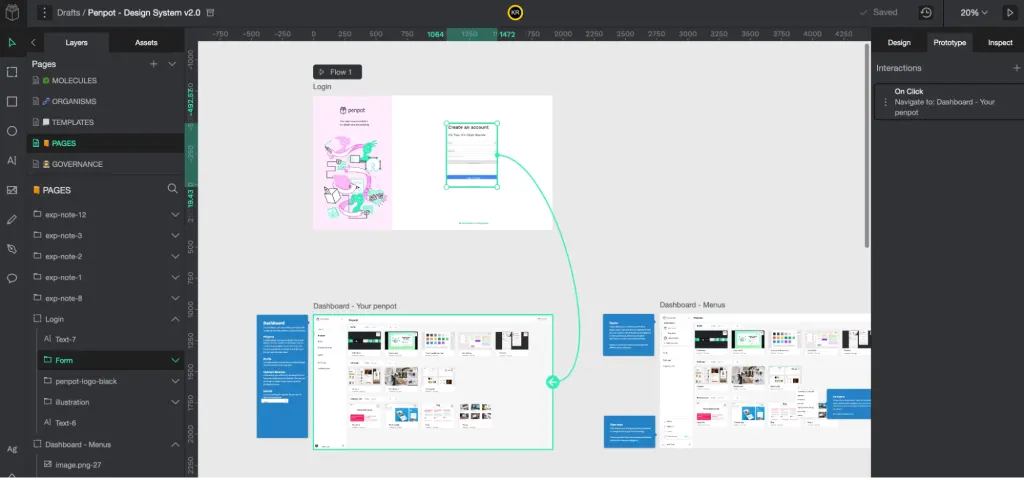
Image Courtesy: Interaction Design Foundation
Penpot is also an open-source prototyping tool that allows collaboration during the design process. It helps create interactive and shareable prototypes for mockups and wireframes. It is a browser-based app that claims to be free forever for individual users.
Skill Level:
Suitable for individuals looking for a quick, easy-to-understand, and hassle-free app to create diagrams and flowcharts.
Pros:
– Free and easy to use
– Supports collaboration
Cons:
– Lacks frequent updates
– Limited features
Available on:
Web browser
Price:
Free
4. Pencil Project

Image Courtesy: The Product Manager
Pencil Project is a free and open-source graphical user interface tool used for wireframing and prototyping. It allows you to access a library of various built-in templates (all-purpose shapes, stencils, desktop/web designs, and flowchart elements), which can help you create different low-fidelity wireframes, especially if you are a beginner. You can further link these elements quickly with the connector tool and page linking option. It has a decent collection of interactive elements but is mostly known for its capability to create diagrams.
Skill Level:
Suitable for designers who are just starting out or individuals looking for basic wireframes.
Pros:
– Absolutely free and easy to use
– Go-to for newbie designers looking for inspiration, mockups, and quicker turn-around
– Offers the color picker option
Cons:
– Limited collaboration features, so not a great option for a large design team
– Not enough interactive elements
– Lacks frequent updates
Available on:
macOS, Windows, and Firefox web browser
Price:
Free
Paid Wireframe Tools Every Designer Should Use
1. Justinmind
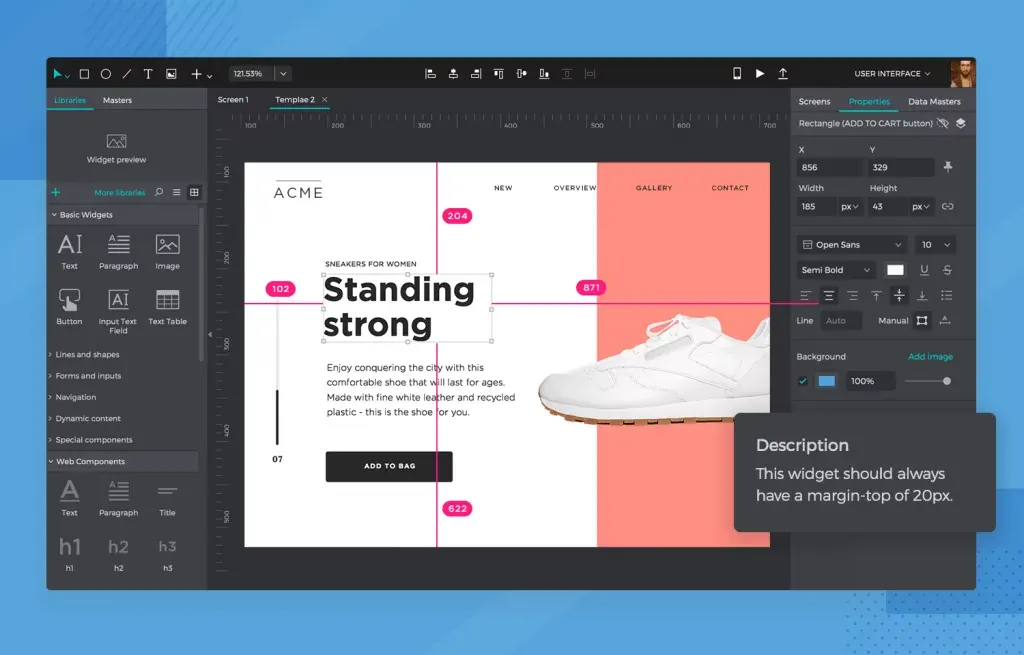
Image Courtesy: Justinmind
Justinmind is a popular wireframing tool designed specifically for designers with limited tech knowledge. It is a simple and straightforward platform that makes learning to design easy and less intimidating compared to other options in the market.
This tool allows you to create wireframes that can be tested in real time right from the get-go. Known for its interactive prototype elements, such as clickable dropdowns, text inputs, and radio buttons, Justinmind lets you integrate all of this into your wireframe designs with a single click.
Skill Level:
Suitable for designers with no coding expertise, particularly those who prefer simplicity and quick feedback in the early design stage.
Pros:
– Even though Justinmind only has desktop access, it allows real-time collaboration with team members
– Great option for someone who wants quick design feedback in the early wireframe stage with the bare minimum effort
– Includes a range of built-in UI elements that are frequently updated and also allow you to import your own
Cons:
– Lacks a web version, so you need to download the app
– Co-editing isn’t available for the free plan
Available on:
macOS and Windows
Price:
– Free plan comes with generous features
– Standard plan costs $9/month, and comes with real-time collaboration and advanced prototyping features
2. Figma

Image Courtesy: The Product Manager
Figma is one of the most popular and powerful cloud-based design software for creating clickable wireframes and high-fidelity prototypes. It allows users to create up to three projects for free before upgrading to a paid version. The interface is simple and easy to understand and allows the flexibility to experiment with various levels of prototyping.
Although Figma doesn’t include any built-in UI components, it comes with a range of features that lets you create your own or upload a pre-designed kit. All the design work happens in a single workspace where you can brainstorm ideas and navigate between different artboards, pages, and layers, making the design process convenient and seamless. It also allows multiple team members to access, edit, and comment on the designs, ensuring everyone is on the same page.
Skill Level:
Suitable for designers who are looking for a collaborative and simple design tool that requires no coding expertise.
Pros:
– The free plan comes with exciting features, cloud storage, and the benefit of collaborating with team members
– Frequently updated
– Unlimited viewers allowed on a project
Cons:
– Prone to lagging and doesn’t function properly in the absence of a strong internet connection
– Lacks control to restrict viewers’ actions when they access a shared prototype, so it’s best to make changes in the copy instead of the original design
Available on:
macOS, Windows, Web browsers, and Linux
Price:
– Free plan (up to 3 projects and 2 editors)
– Premium plan comes free for students and costs $12/month/editor with unlimited projects
3. Adobe XD
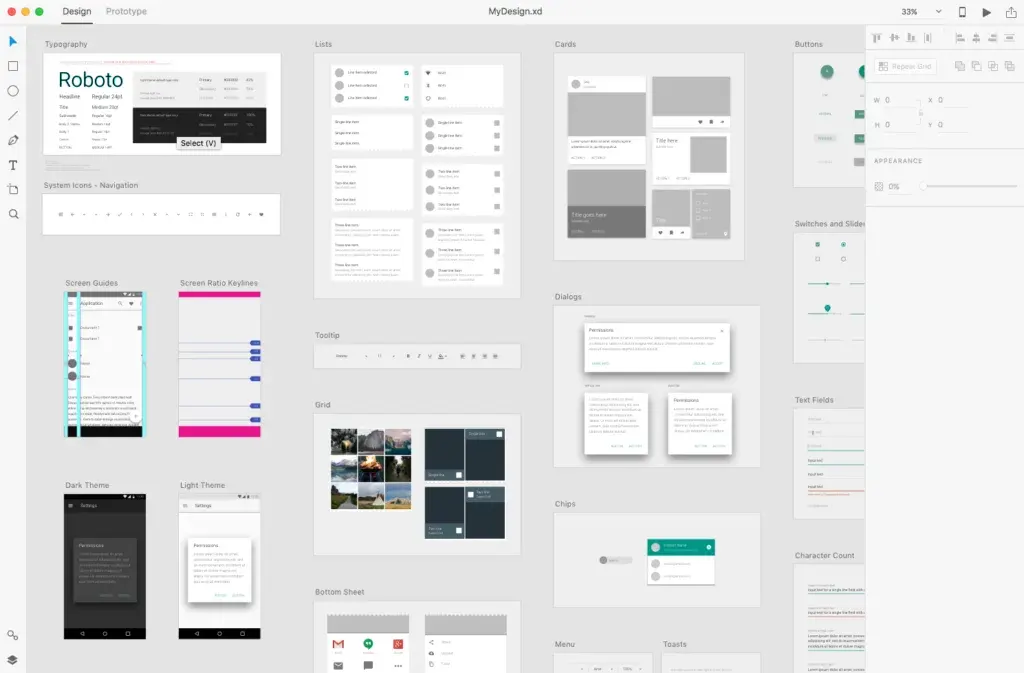
Image Source: The Project Manager
Adobe XD is one of the best-paid, vector-based design tools that is part of the Adobe Creative Suite. It can be used to develop and design anything from websites and storyboards to flowcharts and apps.
This tool makes the process of creating wireframes streamlined and convenient with easy-to-use features. To further speed up the design process, the app offers auto-animation, a repeat grid option, voice triggers, and various collaborative options.
Skill Level:
Suitable for designers who are looking to develop unconventional and dynamic designs rapidly with real-time collaboration.
Pros:
– You can import work done on other Adobe products and streamline your design process
– Access to a range of templates, training videos, and documentation
– Offers co-editing, video exports(macOS only), and document history
– Supports web design, brand design, app design, and game design
– Offers real-time collaboration
Cons:
– Requires an Adobe subscription for access to unlimited features on the platform
Available on:
macOS and Windows
Price:
Costs $9.99/user/month with a 7-day free trial
4. Miro

Image Courtesy: The Project Manager
Miro is an extremely versatile and widely used wireframing tool that enables collaboration and brainstorming sessions with team members in real time as well as asynchronously. It provides features such as screen sharing, video conferencing integration, and a virtual pointer that makes remote communication and collaboration effective.
Miro takes collaboration a step further by allowing team members to leave comments on the canvas and notify specific members, ensuring asynchronous feedback. With a wide range of built-in wireframe templates, realistic sticky notes, intuitive tools, and an infinite canvas, this tool provides a platform for seamless exploration and iteration of designs with your team.
Skill Level:
Suitable for designers who are looking for effective collaboration across remote teams, along with powerful design features.
Pros:
– Offers a good quantity of built-in templates that can be customised to your needs
– Supports both real-time and asynchronous collaboration
– Allows unlimited members in the free version
– Ideal for remote companies
Cons:
– Lacks high-fidelity prototypes and tends to lag occasionally
Available on:
Web browser
Price:
– Free plan comes with collaboration options and is available for unlimited team members ( up to 3 boards)
– Paid version costs anywhere between $8-16/month for teams and comes with unlimited features
5. Sketch
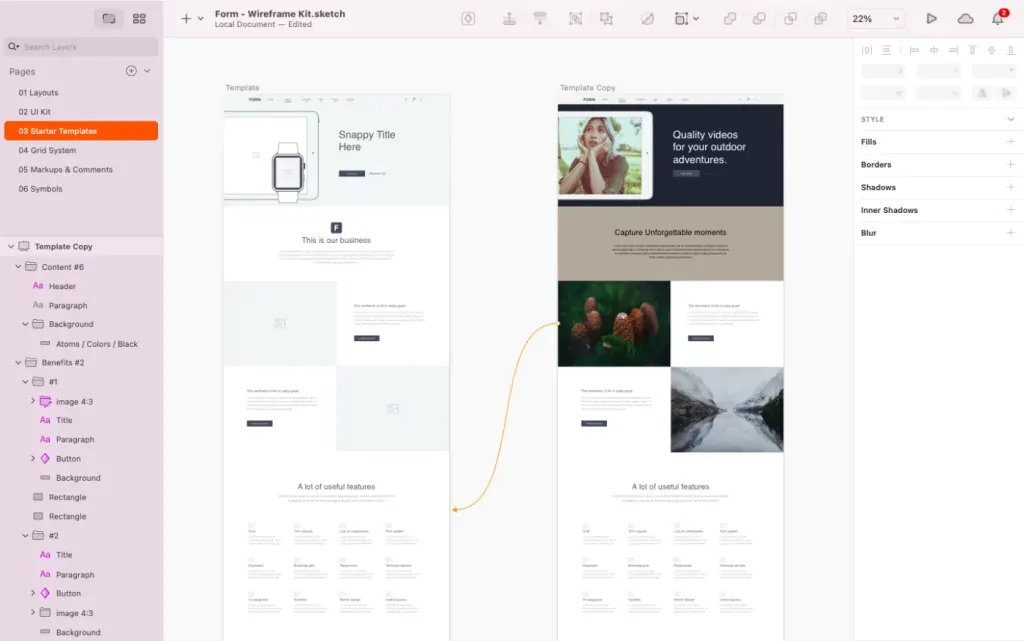
Image Courtesy: Zapier
Sketch is a powerful and lightweight vector design tool specifically created for Mac users. With a simple and user-friendly interface, it stands out as a lightweight alternative to other vector design tools in the market.
Known to produce exceptionally interactive and visually stunning interfaces, this tool can create wireframes in no time and supports rapid design and real-time collaboration. Since it lacks built-in UI components, you will need to either create your own components or choose from a wealth of design elements online, where designers often share their wireframe kits for free.
Skill Level:
Suitable for intermediate designers who are looking for a lightweight vector design tool with effective real-time collaboration.
Pros:
– Intuitive interface
– Supports real-time collaboration
– Includes an ecosystem of plug-ins to improve design workflow
– Maintains quality even when scaled
– Offers unlimited viewers
– Allows offline editing capability
Cons:
– Only designed for Mac users
– Limited prototyping capabilities
– Difficult to master advanced features
– Lacks built-in UI components
Available on:
macOS
Price:
– Costs $9/user/month and comes with a 30-day free trial
6. Framer
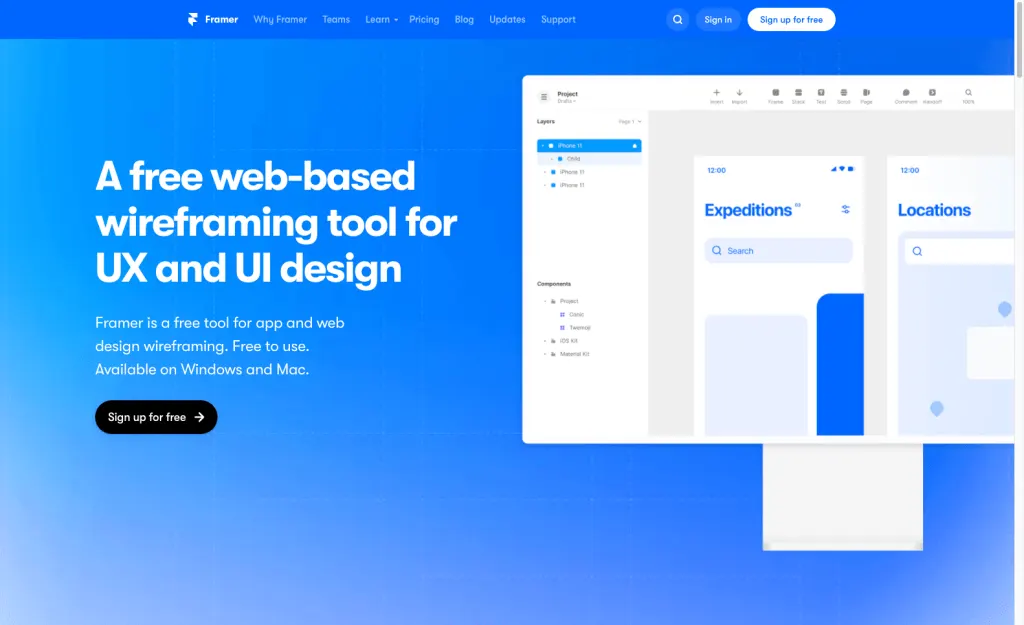
Image Courtesy: Flux Academy
Framer is a renowned wireframing and prototyping tool that comes with a comprehensive free plan and various paid plans. Its prototyping components show different visual states, providing a realistic preview of your design and allowing you to customize the elements and control the animation across screen transitions.
Unlike other design tools, Framer speeds up the design workflow as it enables you to translate wireframes into prototypes using the same tool. Known to have a focus on collaboration and code-based design, this tool empowers designers to create visually captivating and interactive user interfaces.
Skill Level:
Suitable for designers with coding skills looking for an affordable yet effective wireframing tool with real-time collaboration.
Pros:
– Generous free plan
– Empowers designers with coding skills
– Supports real-time collaboration
– Offers live commenting and shared project views
– Accelerates design workflow
– Offers UI components, ready-made kits, and templates
– Supports website creation
Cons:
– Not intuitive and beginner-friendly
– Complicated pricing structure
Available on:
Windows and macOS
Price:
– Free plan (up to 3 projects and 2 editors)
– Basic plan costs $8.75/user/month
– Premium plan costs $17.4/user/month
How To Choose The Right Wireframing Tools?
When choosing a wireframe tool, there is no one-size-fits-all solution. Your choice largely depends on your objectives, preferences, expected outcomes, and any factors specific to your needs. Start with a strategic approach by considering the following key factors.
1. Design Goals
The first step before choosing a wireframe tool is to assess if it can meet your needs and design goals. This will help you narrow down your challenges and ensure that the tool suits your project’s demands.
2. Team Size
A smaller team or individual designer requires an easy-to-use interface with efficient workflow, ideally at an affordable price. On the other hand, a larger team ideally requires real-time communication and collaborative features that allow more control over the designs with on-time feedback. Picking a tool that aligns with your team size improves your design process and optimises collaboration.
3. Built-In UI Components or Uploadable UI Tool Kit
Ideally, it’s best to pick a wireframe app that either includes built-in UI components with powerful features or at least allows you to upload your own kit. Be mindful of the same when choosing a wireframe tool.
4. Explore Tools Before Settling on One
The market is full of both paid and free wireframe tools offering generous features. Explore various options as per your requirements and pick a tool that solves your unique problem.
5. Level of Fidelity
Depending on the level of fidelity you want to achieve, choose a wireframe tool based on your needs – opt for high-fidelity wireframe tools for detailed and realistic outcomes or low-fidelity wireframe tools for quick feedback on simple and abstract ideas.
Conclusion
We hope that our carefully curated list of both free and paid wireframe tools has provided the clarity you were looking for. The selection of an appropriate wireframing tool can have a substantial impact on the development of an intuitive and efficient app or website. While each software has its unique features with benefits and drawbacks, it is essential to be mindful of your individual needs when choosing the tool that’s right for you.
Enrolling in a UX design course is beneficial if you want to use wireframe tools because it provides structured learning, hands-on experience, and a comprehensive understanding of user experience principles. It equips you with the skills and knowledge to effectively use wireframe tools in the context of broader UX design, ensuring you can create meaningful and user-centric digital experiences.
If you’d like to learn more about UX design, consider going through the following resources:
- Watch this session by Shiva Viswanathan, Design Head of Ogilvy Pennywise, and Naman Singh, Product Experience Designer at RED.
- Talk to a course advisor to discuss how you can transform your career with one of our courses.
- Pursue our UX UI Design courses – all courses are taught through live, interactive classes by industry experts, and some even offer a Job Guarantee.
- Take advantage of the scholarship and funding options that come with our courses to overcome any financial hurdle on the path of your career transformation.
Note: All information and/or data from external sources is believed to be accurate as of the date of publication.









